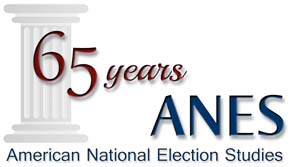Post developed by Katie Brown.
This post is part of a series celebrating the 65th anniversary of the American National Election Studies (ANES). The posts will seek to highlight some of the many ways in which the ANES has benefited scholarship, the public, and the advancement of science.
University of Michigan political scientists Angus Campbell, Philip E. Converse, Warren E. Miller, and Donald E. Stokes published The American Voter in 1960. The American Voter takes root in a time of changing notions about individuals and decision-making. In the 1940s, Paul Lazarsfeld and the Columbia school placed a new emphasis on demographic factors in responses to media and support for President Franklin D. Roosevelt.
 In The American Voter, Campbell, Converse, Miller, and Stokes became part of this behavioral revolution as they considered audience traits in the context of politics. The main argument of the book holds that most American voters cast their ballots on the basis of party identification. Specifically, voter decisions pass through a funnel. At the opening of the funnel is party identification. With this lens, voters process issue agenda. They then narrow down to evaluate candidate traits. Finally, at the small end of the funnel is vote choice. This understanding of voters encompasses the “Michigan Model.”
In The American Voter, Campbell, Converse, Miller, and Stokes became part of this behavioral revolution as they considered audience traits in the context of politics. The main argument of the book holds that most American voters cast their ballots on the basis of party identification. Specifically, voter decisions pass through a funnel. At the opening of the funnel is party identification. With this lens, voters process issue agenda. They then narrow down to evaluate candidate traits. Finally, at the small end of the funnel is vote choice. This understanding of voters encompasses the “Michigan Model.”
In time, the Michigan Model was revised. The original Michigan Model held party identification as king. This thesis maps onto the strong post-World War II Democratic party, strengthened by Roosevelt. In the next few decades, party identification weakened. More recently, party identification reemerged stronger than ever due to a variety of factors, including changing campaign strategy and polarization.
So while these new generations of scholars find different balances between party identification and other factors influencing vote choice, The American Voter provided a bar against which this change could be measured.
The American Voter also enabled the tools of measurement with ANES. The American Voter utilized early waves of what would become the American National Election Studies (ANES), which Miller himself facilitated. The ANES developed into a multi-wave, decade-spanning project offering continuous data on the American electorate since 1948.
Cited over 6,500 times to date, the book remains a seminal text in political science.


